Public SaaS roadmaps can give startup founders and product managers a competitive edge.
The ability to develop better products starts with creating roadmaps that are logical, informative, and motivating. It then comes as no surprise how public SaaS product roadmaps have become an essential strategy among startups.
However, many companies still miss out on implementing this valuable tactic for their own products. SaaS founders and product managers often struggle to share or provide structure onto where their businesses are headed.
In this article, we’ll help address this challenge with a thorough review of some of the best public SaaS roadmaps in the market plus useful tools and actionable recommendations that will guide you to create your own dynamic public SaaS roadmap.
What is a public roadmap?
A SaaS public roadmap is a visual illustration that shows what a company is currently focusing on, what they’ve recently launched, and a general idea of their overall plan for their product. The key factor is that this visual representation is open for anyone to see, making accuracy critical in the process of drafting your roadmap.
Typically, public SaaS roadmaps show a timeline of upcoming work or indicate a general sense of when relevant features might be introduced. It’s a way for the company to be transparent about their plans and keep their users informed about the direction their product is heading.
What is a public roadmap for?
Roadmaps provide structure for a product team’s overall strategic plan. It plays a pivotal role in establishing what needs to be delivered, why it’s important, and when it should be operational. Essentially, they are effective means of communicating and aligning internal team deliverables and external stakeholders’ expectations.In order to create an effective public roadmap, it needs to:
- Ignite Interest – Capture the curiosity of potential customers and current users by giving them a sneak peek into exciting features, innovations, and improvements on the horizon.
- Forge Connections – Establish a genuine connection between product managers and users, creating a shared journey towards product success.
- Promote Transparency – Share and celebrate your product openly, turning users into advocates.
- Updated and Evolving – Good roadmaps are reliable in a sense that they are up to date and constantly optimized to reflect any upcoming changes.
In essence, a good public product roadmap is your trust-building, excitement-generating ally. It’s the key to providing users with updates on what’s coming and exactly when it will be available. Let it be the driving force behind retaining your current users and attracting new ones.
Why should you use a public roadmap?
Public roadmaps primarily cater to the interests of both current and potential customers, honing in on areas that users find most crucial with a commitment to clarity and transparency. Beyond customer-centricity, these roadmaps play a crucial role in aligning various teams within your organization – be it marketing, communications, legal, sales, or customer success.
It’s important, however, not to drown your public roadmap in excessive detail. Users aren’t necessarily interested in intricate technical integrations. The key is to strike a balance – enough information to engage and inform, without overwhelming your audience.
The ultimate goal of your roadmap should revolve around eliciting feedback from existing customers and capturing the attention of future users. So, keep it straightforward, to the point, and concentrate on highlighting the most pivotal features.
Now, let’s explore the best possible examples you can pattern your public SaaS roadmaps after.
6 Best Public SaaS Roadmap Examples
The most effective public roadmaps are those that are openly accessible, easy to understand, and actively involve customers through engagement from the product team.
Explore our curated compilation of public product roadmaps, where the emphasis on transparency is particularly beneficial for SaaS companies. An open and clear public roadmap not only enhances the user experience but also contributes to boosting sales for your software business.
1. Slack
Why it’s good: It’s easy to understand with its simple and straightforward layout
What could be changed: Toning down the technical jargon to more comprehensible terminologies for average users. It could also use specific timelines, showing clients when they can expect the listed updates and features to be available.
2. GitHub
Why it’s good: It’s well-organized per quarter, updated to the latest information available, and provides extensive details on what clients can expect during each time frame. GutHub has likewise provided a guide to the roadmap and a glossary of terms to help audiences understand the roadmap’s contents. Its filtering function is also an excellent way for users to easily find what they need to know about.
What could be changed: Adding brief descriptions pertaining to the purpose of each feature, rather than a technical overview.
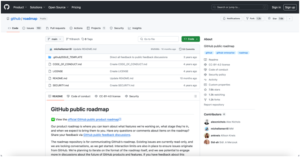
3. Buffer
Why it’s good: Friendly and engaging language, making it easy for users to quickly understand. It also has a clear layout that shows which areas they are prioritizing, and which ones are parked ideas, giving clients a quick reference to determine what to expect.
What could be changed: Providing more concrete timelines for each feature, rather than generic categorization (“Exploring” / “In Progress”).
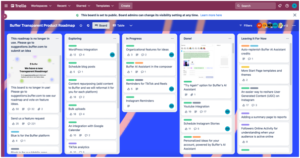
4. Trello
Why it’s good: Offers a complete list of past releases with comprehensive details on how users can implement the new features. Using the Atlassian platform, they are also able to leverage its filtering capabilities, making it easier for users to sort and search for information they need.
What could be changed: Items can be arranged according to progress status to make it clearer for users upon landing on the public product roadmap.
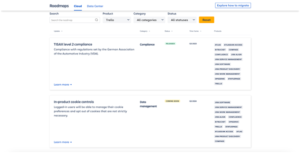
5. Loom
Why it’s good: Organized according to its most current progress status and specific product elements that typically concern users, making it easier for them to locate features they need to see and whether they have been released or are coming soon. It also allows users to request for features through the “Submit Idea” button, engaging their clients and showing them that they are heard.
What could be changed: Adding dates to specify the timelines of each feature drop
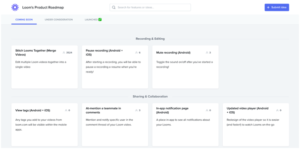
6. ClickUp
Why it’s good: Easy to navigate, clean, and straightforward with detailed release notes dated and sorted from the most recent updates down to the earlier features released.
What could be changed: Provide more context onto the updates each release note contains, rather than using only its version numbers and dates as references. This will make it easier for users to determine where they can read more about the specific features they are interested in.
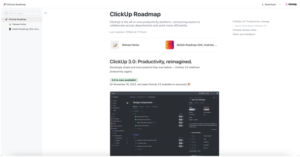
Now that you have seen the best practices and points of improvement in each of the examples, it’s time to delve into creating your own public SaaS roadmap.
How to Build Your Own Public SaaS Roadmap
Step 1: Choose a roadmap tool
Selecting the right tool is important in determining the structure of your roadmap. Beyond its visual impact, consider how your updates will be best categorized, explained, and understood by your client base. The ideal tool should have features that will allow you to:
- Share updates. A roadmap serves as a communication tool, and one impactful way to disseminate information is through announcements. This allows you to directly engage with your customer base, generating excitement about upcoming features.
- Gather user insights. A proficient product team values user feedback, as it informs and validates ideas for future development. An effective roadmap tool should simplify the process of users sharing their comments or making feature requests. Utilizing upvotes and comments provides a swift gauge of user sentiment.
- Provide flexibility. Your product roadmap should offer the flexibility to be either private or public. As discussed earlier, each option comes with its variations and benefits, allowing you to tailor the visibility of your roadmap according to your strategic needs.
Step 2: Structure your roadmap
After selecting a tool, you need to strategically consider how to organize the information to be included in your roadmap. The key lies in establishing a clear structure that maximizes value for your current and potential customers.
Typical roadmap structures contain:
- An overview into features that are dropping soon, upcoming developments, and ideas positioned down the line
- Grouping features based on common themes
- Workflow categorization that reflects in-progress work, feature requests, backlog items, and releases
Step 3: Share your public roadmap, accept feedback, and keep it updated
Launch your public SaaS roadmap by sharing it on different platforms and marketing channels, as well as through engaging current customers to view and share their feedback.
While launching your roadmap is practically the most exciting part of the process, it’s important to remember managing feedback effectively and swiftly. Keep it up to date with the announcement of new features, showing clients how they can benefit from the changes and when they can expect the enhancements to be available.
Best Public SaaS Roadmap Tools
We have established how essential it is to determine the right tool that suits your intended way of communicating and structuring your public SaaS roadmap. Here are the top 3 most popular tools to help you identify which one will work best for your organization.
1.Notion
Notion stands out as a robust knowledge management platform, offering a diverse selection of templates and impressive functionality. The platform’s appeal lies in its user-friendly interface and overall ease of use. If you’re already utilizing Notion for tasks like product documentation, release management, or FAQs, incorporating a public roadmap seamlessly fits into your existing workflow. The convenience of pre-built templates in Notion makes creating a roadmap a straightforward process.
2. Trello
Trello is a web-based application designed for creating kanban-style lists, and the best part? It’s free! Beyond its budget-friendly appeal, Trello boasts user-friendly features. With almost 30,000 instances of a roadmap template in circulation, its popularity is evident. However, it’s worth noting that Trello can become a bit overwhelming, and the avenues for user feedback are somewhat restricted.
3. Roadmap
A dedicated tool crafted for constructing roadmaps, with a remarkably clear user interface caters to non-technical users, facilitating easy engagement. Submitting feedback, comprehending initiatives, and voting on new features are all straightforward tasks with this tool.
Learning the best practices and tools that can help you create your own dynamic public roadmap is only one of the key elements of a successful SaaS startup. However, it’s a fundamental step towards gearing up for a thriving business that keeps its customers and stakeholders in mind through every simple or complex update.
Ready to Unlock your SaaS Success with Expert Guidance?
SaaS Architects is a coaching firm that helps struggling and aspiring SaaS startup entrepreneurs successfully navigate the world of application development, marketing, and sales. Through over 20 years in the software scene, we’ve built hundreds of apps for clients across various industries, learning from every experience.
Now, we are on a mission to make SaaS success simple and accessible for everyone. Our goal is to provide you with thorough guidance– from understanding the technical side of software development to leading you towards a sustainable and profitable business.


